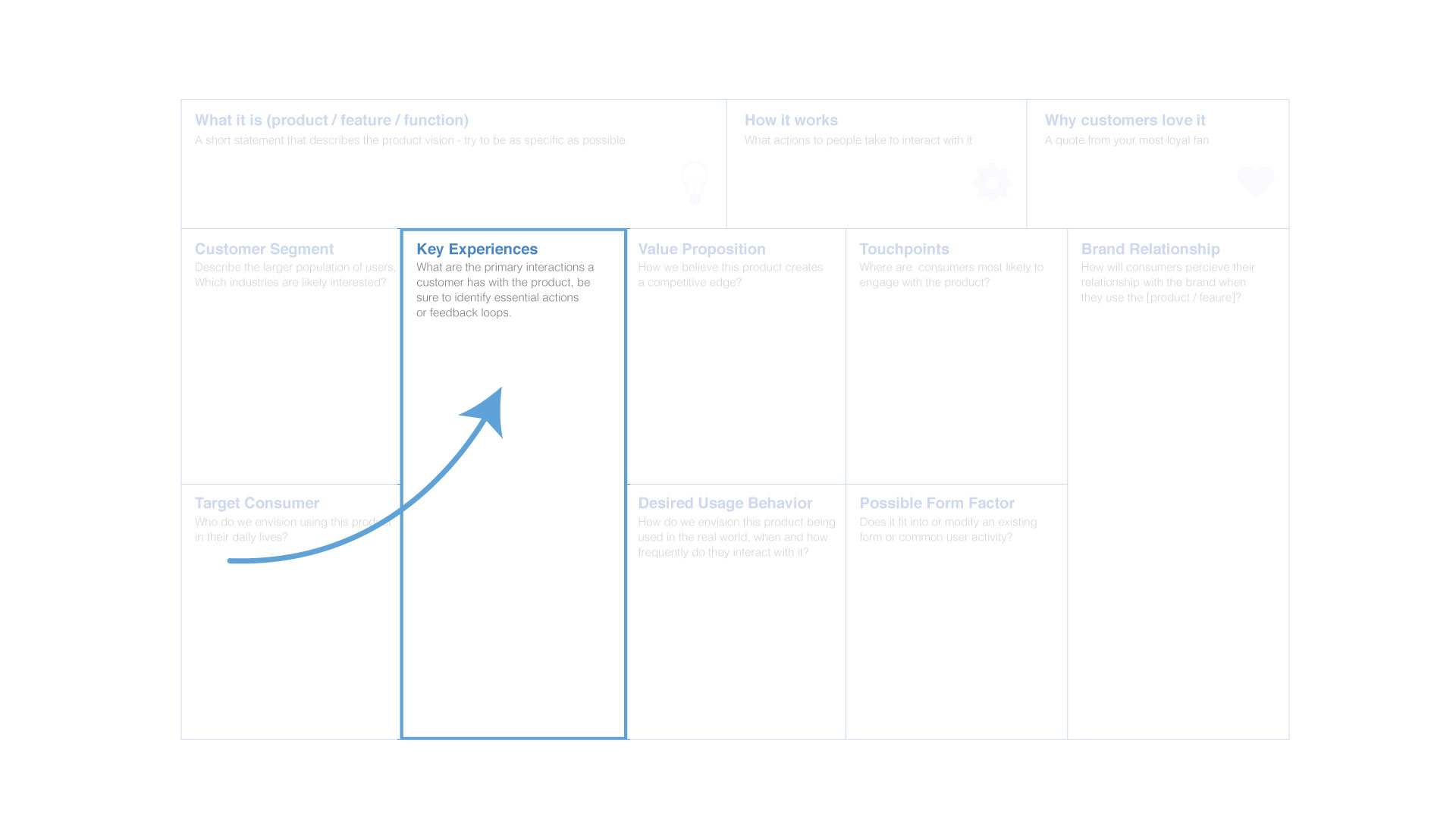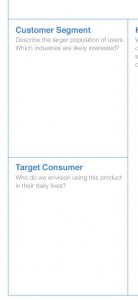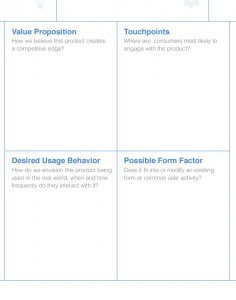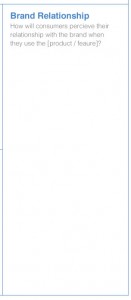About the “canvas” worksheet
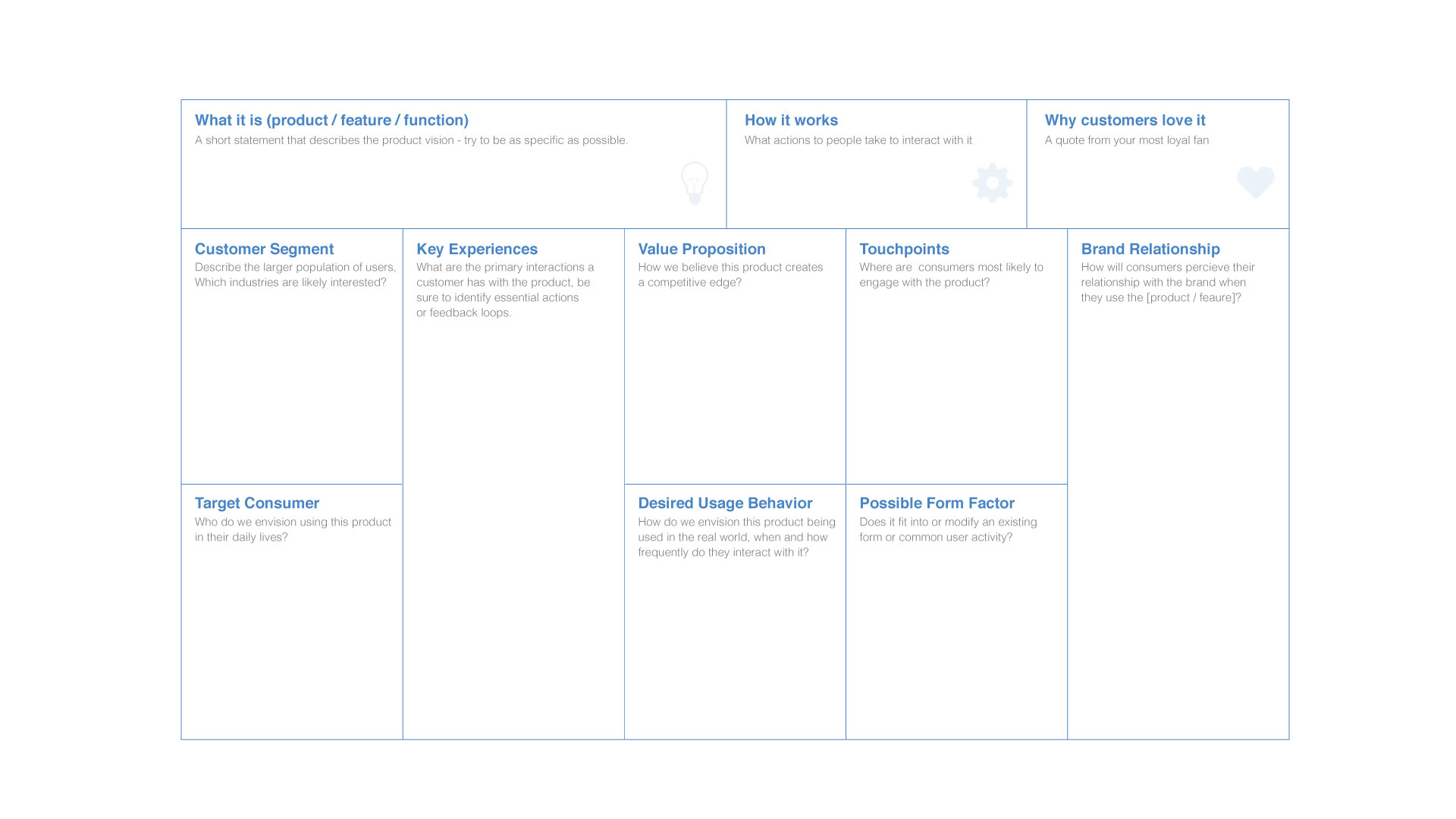
There have been a handful of variations of the “canvas” that have popped up over the last couple of years and I owe a huge thank you to Alex Osterwalder, Alan Smith, Gregor Bernarda, Trish Papadokas, Yves Pigneur and I’m sure others that I’m neglecting but Strategyzer.com is a great resource to explore on this topic.
This post will outline my adaption and use of what I’ve taken to calling the Experience Model Canvas. A one-page framework for capturing and illustrating the core elements of the experience or product you’re looking to create. Use it as a jump off point for team brainstorming, or building consensus and buy-in before you dive into a series of deliverables.
While working on the Wearable Technology UX team at Intel we were blazing a trail in an emerging field and our UX team would frequently meet to brainstorm or “future-cast” and imagine context scenarios where technology could add value to specific use cases. The role on the team involved “path-finding” and concept exploration, which can be somewhat ambiguous or unclear at times. While there part of my role crossed over with defining components for Platform UX and I worked in collaboration with members of the business development and strategy teams. They were engaging with leading iconic brands to communicate capabilities of the microchip roadmap for the next few years and to produce presentation materials to illustrate the user experience and facilitate discussions with them for engagement or form factor reference designs. Our team was an in-house agency of sorts with UX, research, industrial design and innovation, for both Intel and brand partner engagements.
Early Ideation and Brainstorming
When starting the conversation about a new product or a new feature I think it’s important to keep an open mind and allow for any and all ideas to take shape. Do this on your own or invite your team to participate and kick things off with an ideation session, go wide capture any ideas that come to mind, we’ll ask iterative questions and hone in on how to get more tactical once we’ve got a pool of ideas coming together.
Lean In–to the Experience
The experience is a great place to start. Take a few minutes to think about key moments, the moments that create potentially the most friction (can you automate and simplify them), or that have the potential for being most memorable or impactful.
Consider the “magic moment”, or opportunity to deliver an unexpected outcome. Spend a few minutes here and then get ready to start at the beginning (top left), and work your way through the rest of the cells.
Key Experiences
- What are the primary interactions a customer has with the product. Be sure to identify essential actions or feedback loops.
Get your Bearings
There really is no right or wrong way to go about this, the goal is simply to get a framework to have a conversation and capture the components affected and considerations for bringing your product, feature or service to market. I like to approach things in a linear fashion so I’ll typically start at the top left and work my way across, then fill out the cells below. Take a few minutes here to craft the structure of an elevator pitch, describe your product, what is, how it works and why people love it.
What it is
- A short description of the vision for the product, feature or service
How it works
- What actions do users take, what are the essential hardware components
Why customers love it
- Finish this statement from a customer perspective, “I love this product because…”
Customer Segments vs Personas
If you have data or research that defines your segment then you’re ahead of the game and should have a good sense of the industry or category your experience is a good fit for. Your segment is a group or population that shares similar attributes. It may be a broadly defined vertical, but you’ll have better insight thinking about it from the top down gradually narrowing the scope as you go. An example may be runners, members of run clubs, training for half marathon to marathon distance, with a finish goal of between 2:45:00 and 3:15:00. Research will help you understand buying habits, market niche, brand preferences and interests. Once you have a good understanding of the segment you can use those to build persona’s or archetypes that designers will use to craft the experience around. Personas are informed by segments but will have a blend of habits and characteristics that will help designers get a better understanding of the day in the life, or lifecycle of interaction with your products.
Maybe there are also adjacent segments or users that might also be interested in this experience.
Getting to the Experience Heartbeat
The last few cells have been a bit more practical and have helped start to shape a picture in your mind, this next block of cells will ask you to stretch your imagination and creative muscle again. The pulse of the user experience comes to life through the usage behavior and touchpoints. The customer’s perception of the product and how it fits into their life should align with the value proposition and the ergonomics or appropriateness of the form factor.
Value Proposition
- Your product does what, for whom, and how does it serve the customer with a desire to achieve an outcome or scratch an itch – in a way unique only to your brand?
Touchpoints
- Where are the primary, high value and most frequent actions taken (phone, tablet, pc, kiosk, etc..), are secondary actions supported on other devices?
Usage Behavior
- How often is your product interacted with, when and where and for how long? What is your desired behavior and can you leverage any existing common user actions?
Form Factor
- Is your product a physical device, are there ergonomic or other functional considerations?
Brand Relationship
Brand loyalty and mindshare are incredibly valuable. Marketers tend to focus on KPI’s, and numbers that translate to lifetime value, which is important, but take a few minutes here to think about how the experience your working to create will help to reinforce the brand relationship. Are there social implications to the customer’s use of your product such as status or prestige? If there were an intangible or emotional leave behind with the experience what would it be, relief, excitement, enthusiasm? How would your customer share or talk about the experience with others?
Ideation and Iteration
The goal with the canvas for me is to quickly get a one-page framework to cover off on key areas of product design from the perspective of UX. Expect that more questions will shake out and some of your assumptions here will likely change. You can easily kick off a meeting and spend 10 minutes filling in the canvas with your team and spend an hour getting your head around the framework or go a little more in-depth and spend as long as needed. Take a couple of hours with your team and break into small groups and produce multiple canvases and then come back together and trade notes. Once you have a distilled set of insight and direction everyone feels comfortable with start to consider what resources you have available to support testing and development.
This is simply one tool in the toolbox you can build off of, hopefully you find it useful. Once you have it filled out you might start asking yourself additional questions to further the conversation toward a consumer research plan or a high level plan for prototyping and testing some of your hypothesis, then ultimately work your way toward a functional spec.

